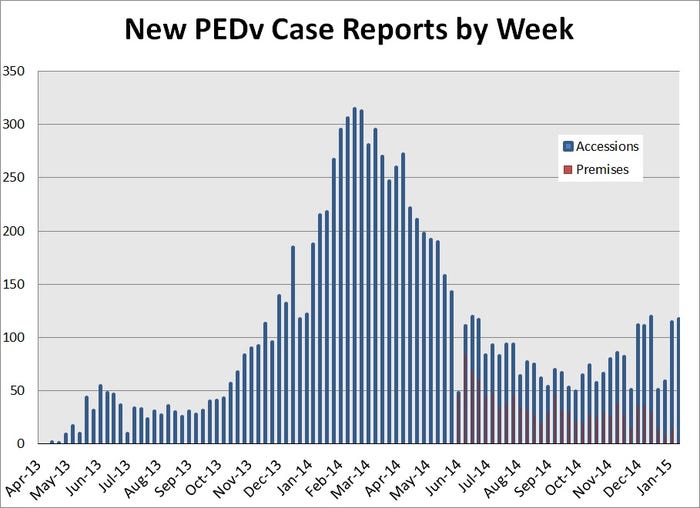Too early to tell whether the U.S. can eliminate it or whether it will become an endemic.
January 27, 2015

It’s too early to tell the future of PEDv, but Dr. Paul Sundberg of the National Pork Board (NPB) told IPPE 2015 attendees that more may be known by 2016. Right now, however, anything can still happen, he said.
Sundberg said the disease has a rather normal epidemic curve (Figure) and that the disease has maintained a lower level of positive accessions despite expectations that numbers would increase during the winter when the disease normally thrives. “As of Jan. 15, we’re still below an epidemic threshold that the University of Minnesota sets given the data that they have. That’s very good news and rather unexpected,” he said.

The current status is indicative of two things, said Sundberg. First, about half of the U.S. sow population was infected so the U.S. has built some immunity. Secondly, he said better biosecurity and better awareness surrounding a lot of different practices have contributed to the decrease in the disease incidents.
While this is good news for now, Sundberg relayed that it is too early to tell whether the U.S. can eliminate it or whether it will become an endemic. “Next year at this time we may know more,” he stated.
In 2015, Sundberg said the number one priority is sow immunity, but survivability of the virus in manure pits will continue to be researched. Additionally, he said there will be more focus on feed interventions rather than feed as a transmission. While feed systems can be a risk if not managed correctly, post-processing contamination presents the largest risk, he added.
A few years ago, Sundberg pointed out that PEDV was a disease only briefly discussed because it wasn’t present in the U.S, but it did emerge. Now, the swine industry recognizes that monitoring all emerging swine diseases in other countries is crucial as they may eventually occur in the U.S.
“We can’t expect USDA alone to protect our herds from emerging disease,” noted Sundberg. Industry needs to take more responsibility for non-regulatory diseases, and better state-federal-industry response coordination is essential, he added.
You May Also Like
.png?width=300&auto=webp&quality=80&disable=upscale)


